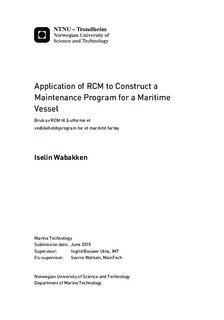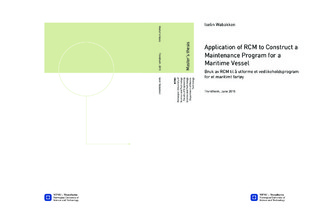| dc.description.abstract | In this thesis an assessment has been carried out to discover whether reliability centred maintenance (RCM) is an applicable method to construct a maintenance program for a specific system on board a vessel within Wilhelmsen Ship Management s (WSM) fleet. Constructing efficient and appropriate maintenance programs for technical equipment on ships has become a key concern in the maritime industry. This is a result of a growing concern towards environmental and safety aspects, as well as an increased usage of capital intensive vessels, giving large downtime costs if normal operation is interrupted (Rasmussen, 2003). Maintenance programs connected to technical ship systems are commonly defined by recommendations from manufacturers and classification societies (Mokashi et al., 2002).
Yet, it is not necessarily given that the recommended practices are outlined in an optimal manner considering the equipment in its operating context (Linton, 2011, Wang et al., 2010). Henceforth, the issue addressed within the present study is how the RCM practice can be employed as an alternative approach, which is of relevance to create a maintenance program more on the premises of the equipment. This has been achieved by analysing an engine and its auxiliary systems installed on a vessel operated by WSM. These included the engine s sea- and freshwater cooling system, lubrication oil system and fuel system. The purpose has been to evaluate the RCM applicability in a maritime context and discuss if the resulting maintenance program could obtain an improved effect for a vessel s operation compared to following the common trend in traditional maritime maintenance.
The development of the analysis is based on the RCM perspective of Moubray (1997) and criteria outlined in SAE International (1999). The technique provides advantages in handling various equipment and focuses on maintaining the function of a system in a cost effective manner (Selvik and Aven, 2011). The analysis was performed for the equipment through four stages. This involved establishing function descriptions, functional failures, failure modes, effects and criticality (FMECA) worksheets and proper maintenance tasks, focusing on each listed failure mode. System explanations were also included to describe the equipment being analysed. Criticality and risk evaluations were carried out in accordance with WSM s outlined consequence parameters and risk matrix. The majority of the data input was set during an RCM workshop at WSM s office. The first three stages founded the necessary basis to determine the final maintenance program.
Applying the RCM process on the engine determined that the most critical failure modes potentially leading to engine stop were failure of its auxiliary systems, disregarding any engine component failure. The FMECA pointed out that the majority of failure modes at the lowest causation level were considered to have low criticality. Failure modes obtaining the highest risk indexes were:
Closing valve failure and blackout of switchboards in the seawater cooling system
Lack of chemical dosing in the freshwater cooling system
Contaminated oil, filter failure and old oil in the lubrication oil system
Wear/fatigue and assembly error for the purifier in the fuel oil system
The information gathered in the FMECA enabled tailoring the maintenance to handle each evaluated failure mode, resulting in a program of both corrective and preventive actions. Further, the results were structured to provide a framework for continuous improvement and update of the maintenance program.
The results provided a thorough arrangement of equipment data applicable for legitimating the choice of tasks in the maintenance program. Most of the evaluated failure modes received low risk indexes, resulting in more corrective means than expected. This indicated that it could be relevant for WSM to evaluate the vessel s spare part program. The diversity of tasks in the maintenance program corresponded well to the perception of RCM prioritising actions that improve system reliability.
Due to limited time during the RCM workshop, the volume of equipment included in the analysis had to be reduced from the initial plan. However, this illustrated one of the known drawbacks of RCM, which is its extensive need for time and resources. From the analysis, it is clear that RCM may very well suit a maritime context. Constructing a maintenance program by employing this practice would provide beneficial results for a shipping company. Yet, the method is mainly considered applicable to fit equipment that by function failure would be critical towards safety and/or operation. | |

